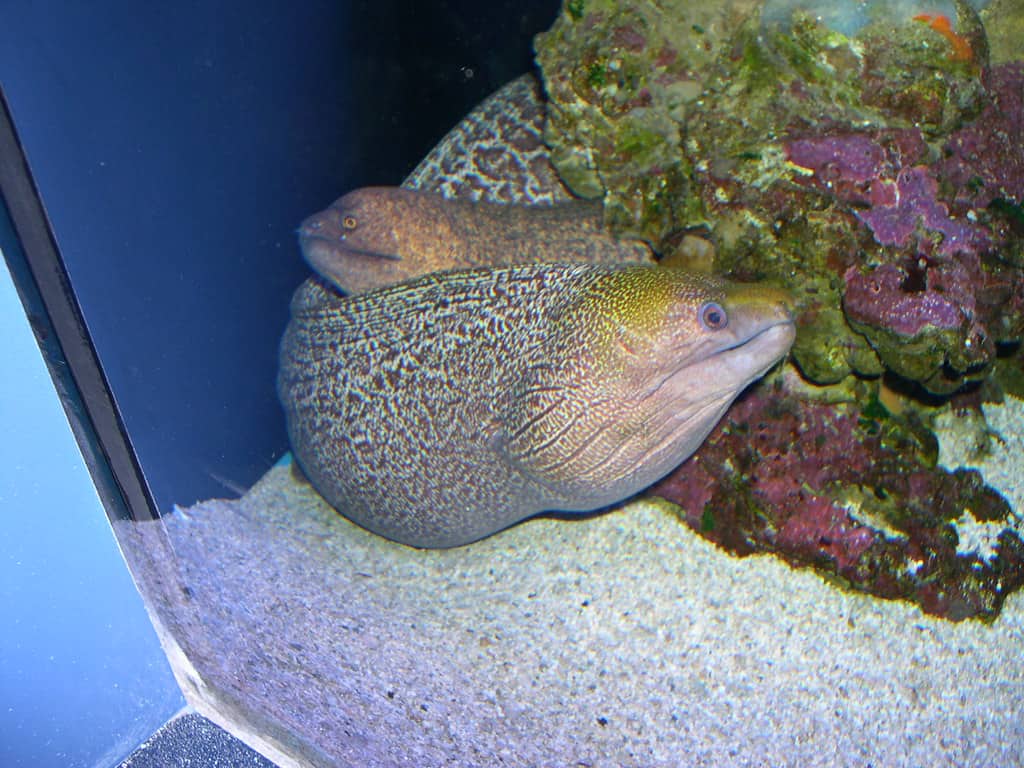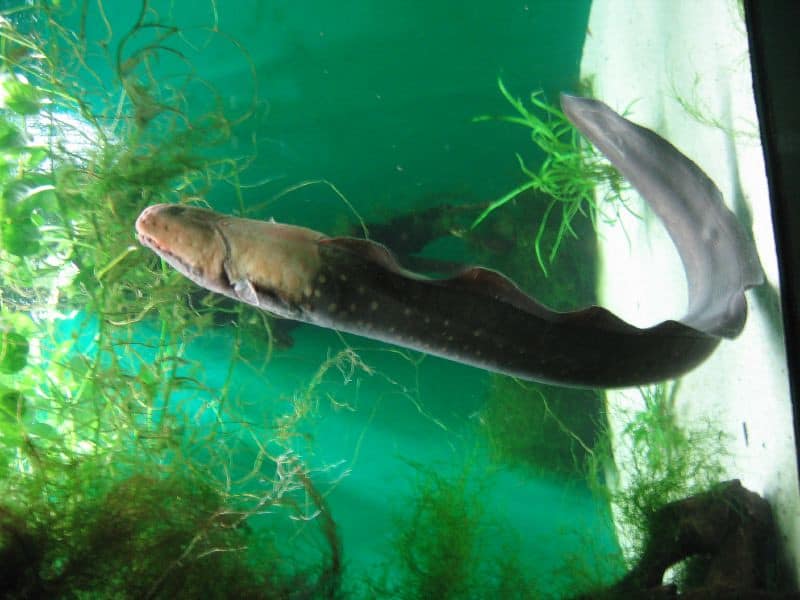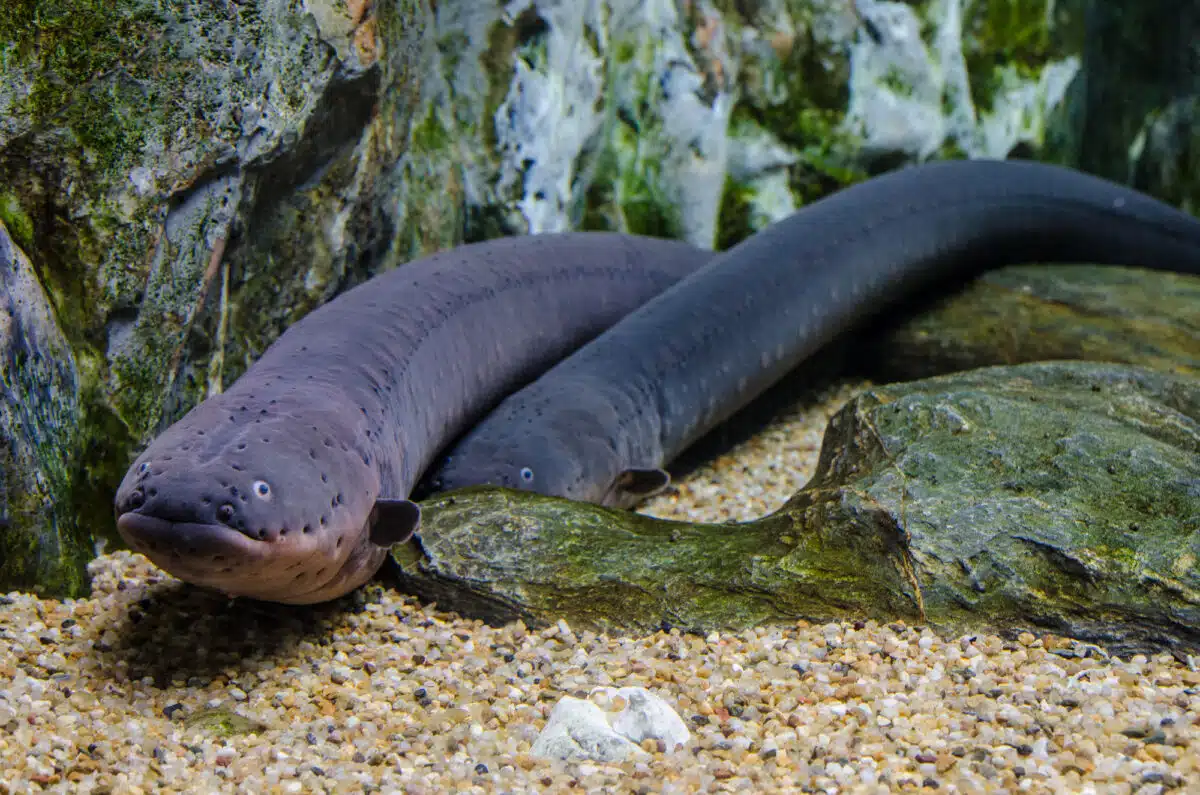The Amazon rainforest holds countless mysteries, but few creatures are as shocking as the electric eel. This remarkable fish has been electrifying scientists and nature lovers for centuries with its incredible ability to generate powerful electrical discharges. Despite their name, these fascinating creatures aren’t actually eels at all, which is just the beginning of the surprises they have in store. From their unique hunting strategies to their mind-blowing electrical capabilities, electric eels are living proof that nature’s engineering often surpasses human imagination. Get ready to dive into the electrifying world of one of the most extraordinary predators on Earth.
17. Electric Eels Aren’t Actually Eels

Here’s a shocker that might leave you stunned – electric eels aren’t eels at all! These incredible creatures are actually a type of knifefish, more closely related to catfish and carp than to true eels. The confusion comes from their long, snake-like body shape that resembles an eel, but genetically speaking, they’re worlds apart. True eels belong to the order Anguilliformes, while electric eels are part of the Gymnotiformes order. This mix-up has persisted for so long that even today, most people don’t realize they’re looking at a completely different type of fish. It’s like calling a dolphin a fish when it’s actually a mammal – sometimes appearances can be deceiving!
16. They Can Generate Up to 860 Volts of Electricity

Imagine touching a live wire – that’s essentially what happens when you encounter an electric eel’s full-power discharge. These living batteries can generate up to 860 volts of electricity, which is enough to power several household light bulbs simultaneously. To put this in perspective, a standard household outlet in North America delivers 120 volts, making the electric eel more than seven times more powerful. This incredible voltage is produced through specialized cells called electrocytes that work like biological batteries stacked in series. The most powerful recorded discharge was strong enough to knock a full-grown horse off its feet. It’s nature’s own high-voltage power plant swimming through the murky waters of South America.
15. Their Electric Organs Take Up 80% of Their Body

Electric eels are essentially swimming power plants, and their anatomy reflects this incredible specialization. A staggering 80% of their body mass is dedicated to three different electric organs – the main organ, Hunter’s organ, and Sach’s organ. Think of it like a car where the engine takes up most of the space, leaving little room for anything else. The main organ and Hunter’s organ are responsible for those powerful defensive and hunting shocks, while Sach’s organ produces weaker electrical fields for navigation and communication. This means their vital organs like the heart, digestive system, and gills are all crammed into just 20% of their body space. It’s an evolutionary trade-off that has made them one of the most electrically gifted creatures on the planet.
14. They Use Electricity Like Radar

Electric eels are the ultimate underwater detectives, using electricity as their primary sense in the murky Amazon waters. They constantly emit weak electrical pulses, creating an invisible electric field around their body that acts like a biological radar system. When objects enter this field, they distort the electrical pattern, allowing the eel to “see” its surroundings without using its eyes. This electroreception is so precise that they can distinguish between different materials, detect the size and shape of objects, and even sense the electrical activity of other living creatures. It’s like having a superpower that lets you navigate in complete darkness while simultaneously detecting hidden prey. This electrical sixth sense makes them incredibly efficient hunters, even in the darkest, muddiest waters where vision is useless.
13. They Can Grow Up to 8 Feet Long

Electric eels are not just shocking – they’re impressively massive too. These aquatic giants can reach lengths of up to 8 feet and weigh as much as 44 pounds, making them one of the largest freshwater fish in South America. Picture a creature longer than most adults are tall, silently gliding through the water with the power to deliver a devastating electrical shock. Most electric eels reach about 6 feet in length, but the largest specimens are truly awe-inspiring. Their size advantage, combined with their electrical abilities, makes them apex predators in their habitat. Female electric eels tend to grow larger than males, and their impressive size helps them store more electrical energy in their specialized organs.
12. Baby Electric Eels Are Called Larvae, Not Fry

Unlike most fish babies that are called fry, young electric eels start life as larvae – a term usually reserved for insects and amphibians. These tiny larvae are born already equipped with basic electrical abilities, though nowhere near as powerful as their parents. Baby electric eels are incredibly vulnerable during their first few months, measuring only about half an inch long when they hatch. They rely on their weak electrical discharges mainly for navigation and communication rather than hunting. The larvae feed on small invertebrates and gradually develop their electrical organs as they grow. It takes several years for them to reach adult size and develop their full electrical potential, making their journey to adulthood both fascinating and perilous.
11. They Breathe Air, Not Just Water

Here’s something that would surprise most people – electric eels are actually air-breathers! While they live in water, they must surface every 10 minutes or so to gulp fresh air through their mouths. They have a specialized organ in their mouth that acts like a primitive lung, allowing them to extract oxygen directly from the air. This adaptation is crucial for their survival in the oxygen-poor waters of the Amazon basin, where traditional gills alone wouldn’t provide enough oxygen. Think of them as aquatic mammals in fish form – they’re completely dependent on water for living but need air to survive. If prevented from reaching the surface, an electric eel will actually drown, just like a whale or dolphin would.
10. They Can Live Up to 22 Years

Electric eels are surprisingly long-lived creatures, with some individuals reaching 22 years of age in the wild. This impressive lifespan is quite remarkable for a freshwater fish, especially considering the harsh conditions of their Amazon habitat. Their longevity is partly due to their status as apex predators – very few creatures dare to challenge a fish that can deliver an 800-volt shock. Like fine wine, electric eels seem to get more powerful with age, as their electrical organs continue to develop and strengthen throughout their lives. The oldest recorded electric eel in captivity lived for over 20 years, spending decades as a living demonstration of nature’s incredible electrical engineering. Their long lifespan also means they play a crucial role in maintaining the ecological balance of their river systems for decades.
9. They Have Three Different Types of Electric Discharges

Electric eels are like living Swiss Army knives when it comes to electrical output – they have three distinct types of discharges for different purposes. Their low-voltage pulses (around 10 volts) are used constantly for navigation and communication, like a biological GPS system. Medium-voltage discharges (around 400 volts) are used for stunning prey, delivering just enough power to immobilize fish without wasting energy. The high-voltage blasts (up to 860 volts) are reserved for serious threats and self-defense, capable of deterring even large predators like caimans. It’s like having a dimmer switch, regular light, and emergency floodlight all built into one system. This versatility allows them to be incredibly energy-efficient while maintaining their effectiveness as both hunters and survivors in the competitive Amazon ecosystem.
8. They Can Remotely Control Their Prey

Perhaps the most mind-blowing ability of electric eels is their capacity to literally remote-control other fish. When hunting, they can deliver precise electrical pulses that hijack the nervous system of nearby prey, causing involuntary muscle contractions that make fish twitch and reveal their location. It’s like having a biological remote control that forces hidden prey to give away their position. Once the prey is located, the eel can deliver a stunning shock to immobilize it completely. This strategy is so effective that electric eels can hunt successfully even when their prey is hiding among plants or buried in mud. Scientists have compared this ability to a puppeteer controlling marionettes, except the strings are made of electricity. This remote-control hunting technique makes them one of the most sophisticated predators in the animal kingdom.
7. Ancient People Used Them for Medical Treatment

Long before modern medicine, ancient civilizations discovered the therapeutic potential of electric eel shocks. Indigenous people of South America used controlled electric eel discharges to treat various ailments, including headaches, arthritis, and paralysis. The ancient Greeks and Romans also documented the use of electric fish for medical purposes, believing their shocks could cure certain conditions. This early form of electrotherapy was actually quite advanced for its time, predating modern electrical medical treatments by thousands of years. Some historical accounts describe patients being instructed to touch electric eels or stand in water with them to receive treatment. While we now understand electricity’s medical applications much better, these ancient practices show that humans have long recognized the therapeutic potential of bioelectricity.
6. They Were the Inspiration for the First Battery

The electric eel played a crucial role in one of humanity’s most important inventions – the battery. Alessandro Volta, the Italian physicist after whom the “volt” is named, was inspired by electric fish when he created the first true battery in 1800. Volta’s “voltaic pile” was designed to mimic the way electric eels generate electricity through stacked cells. The principle is remarkably similar – both use multiple units (electrocytes in eels, metal discs in batteries) arranged in series to build up voltage. This biological inspiration led to the development of all modern batteries, from the ones in your smartphone to those powering electric cars. It’s amazing to think that every electronic device we use today traces its power source back to the ingenious design of the electric eel. Nature truly was the first electrical engineer.
5. They Have Poor Eyesight But Incredible Electric Vision

Electric eels have notoriously poor eyesight, with small eyes that can barely distinguish between light and dark. However, this apparent disadvantage is more than compensated by their extraordinary electroreception abilities. Their electrical sense is so refined that it provides them with a detailed three-dimensional map of their surroundings, arguably superior to vision in murky water conditions. They can detect the electrical signatures of living creatures from several feet away, sensing heartbeats and muscle contractions with remarkable precision. This electric “vision” works in complete darkness and isn’t affected by the sediment-filled waters of their habitat. Think of it as trading normal eyesight for a superpower that works better than vision in their environment – it’s like having X-ray vision combined with motion detection.
4. They Can Jump Out of Water to Attack

In a behavior that seems straight out of a horror movie, electric eels can actually leap out of the water to attack threats on land. This incredible defensive strategy was first documented by explorer Alexander von Humboldt in the 1800s but was long dismissed as exaggeration. Recent scientific studies have confirmed that electric eels will indeed launch themselves partway out of the water to deliver powerful shocks to perceived threats. When they make contact with a target above water, they can deliver their full electrical charge with even greater efficiency than underwater attacks. This aerial assault is typically reserved for large threats that they can’t easily escape from. The sight of a 6-foot electric eel launching itself from the water while delivering hundreds of volts of electricity is both terrifying and awe-inspiring.
3. There Are Actually Three Different Species

For over 250 years, scientists believed there was only one species of electric eel, but recent DNA analysis has revealed a shocking truth – there are actually three distinct species. The newly discovered species have been named Electrophorus electricus (the original), Electrophorus voltai, and Electrophorus varii. Electrophorus voltai holds the record for the strongest bioelectrical discharge of any animal, capable of generating up to 860 volts. Each species has adapted to different regions of the Amazon basin and has slight variations in their electrical capabilities and physical characteristics. This discovery has rewritten the textbooks and shown that even well-studied animals can still surprise us. The fact that we’re still discovering new species of such iconic creatures proves that the Amazon continues to hold secrets waiting to be unlocked.
2. They Can Disable Electronic Equipment

Electric eels are nature’s ultimate EMP devices, capable of disrupting and disabling electronic equipment with their powerful electrical discharges. Researchers studying these creatures have reported instances of underwater cameras, recording equipment, and even boat electronics being affected by nearby electric eel activity. The electromagnetic pulse generated by their discharge can interfere with sensitive electronic circuits, much like a natural electromagnetic pulse weapon. This has created unique challenges for scientists trying to study them, as traditional electronic monitoring equipment can be rendered useless. Some research teams have had to develop specially shielded equipment or use alternative methods to observe electric eel behavior safely. It’s like having a living jamming device that can knock out technology just by being defensive.
1. They’re Surprisingly Social Creatures

Despite their fearsome reputation, electric eels display surprisingly complex social behaviors that challenge our understanding of fish intelligence. Recent research has revealed that they can coordinate hunting strategies, with multiple individuals working together to corral prey into tight spaces. They communicate through electrical signals, creating a sophisticated underwater language that we’re only beginning to understand. During breeding season, electric eels gather in groups and engage in elaborate courtship displays involving synchronized electrical pulses. Some researchers have observed what appears to be cooperative behavior, where eels share information about food sources and potential threats. This social complexity suggests that electric eels have much more advanced cognitive abilities than previously thought, making them not just powerful predators but intelligent community members of the Amazon ecosystem.
Conclusion

Electric eels continue to amaze scientists and nature enthusiasts with their incredible adaptations and surprising behaviors. From their record-breaking electrical output to their complex social interactions, these remarkable creatures prove that evolution can create truly extraordinary solutions to survival challenges. Their influence extends far beyond their Amazon habitat, having inspired human technology and medical treatments for centuries. As we continue to study these living powerhouses, we discover new aspects of their biology that challenge our understanding of what’s possible in the natural world. What other secrets might these electrifying creatures still be hiding in the depths of the Amazon?
- 11 Signs a Rhino Is About to Charge - August 9, 2025
- 10 Common Chicken Behaviors and What They Mean - August 9, 2025
- 14 Creatures That Can Freeze and Thaw Back to Life - August 9, 2025

